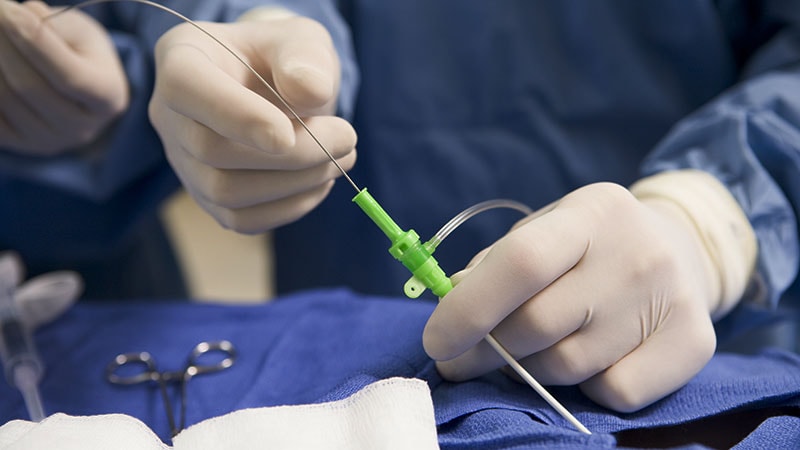A novel study shines a light on the physiological stress interventional cardiologists may encounter when performing complex percutaneous coronary intervention (PCI) procedures.
The study of five experienced operators showed significantly higher heart rate and blood pressure parameters when performing PCI for coronary total occlusion (CTO) — one of the most challenging lesions in patients undergoing PCI — compared with regular work and non-CTO interventions.
“I was flabbergasted that the heart rate increased continuously until the very end of CTO PCI, rather than until the very moment of CTO recanalization, which is perceived as the most difficult part of this procedure,” Maksymilian P. Opolski, MD, PhD, Department of Interventional Cardiology and Angiology, National Institute of Cardiology, Warsaw, Poland, told theheart.org | Medscape Cardiology.
“This observation suggests the cumulative effect of repeated stressors (and constant operator alertness) until the end of CTO PCI without any sort of relief attributed to successful guidewire crossing. Not surprisingly, the highest heart rates were observed during failed CTO PCI attempts,” Opolski noted.
The study was published online on March 6 in the Journal of the American College of Cardiology (JACC): Cardiovascular Interventions.
Occupational Hazard?
As both a researcher and a complex PCI operator performing 150 CTO PCIs per year, Opolski said he is well aware of the potential occupational hazards, both mental and physical, of CTO PCI.
“Paradoxically, while we are used to studying our patients, there is a paucity of data about the influence of PCI in general on physiological reflections of stress among interventional cardiologists,” Opolski said.
About 2 years ago, he came across a report on monitoring the heart rate of chess players during professional competitions and realized that similar methodology, extended to BP monitoring, could be applied to CTO PCI operators. Both chess players and interventional cardiologists face a high demand for continuous mental alertness in the standing or sitting posture, Opolski explained.
For the study, Opolski and colleagues recruited five hybrid CTO operators — all healthy men between 37 and 63 years old — to participate in the study. None had hypertension or cardiovascular disease, and none was taking medication.
A portable ambulatory blood pressure monitoring (ABPM) device recorded daytime assessment of systolic arterial pressure, diastolic arterial pressure, mean arterial pressure (MAP), and heart rate (HR) over 10 working days.
Measurements were taken at 15-minute intervals during regular work outside the catheterization laboratory, CTO PCI, and longer non-CTO procedures (regular PCI) and at 10-minute intervals during shorter non-CTO procedures (angiography, myocardial biopsy, and right heart catheterization).
During the study period, a total of 38 CTO PCI procedures were performed; four operators performed eight CTO PCI and one operator performed six CTO PCI.
The operators also performed 133 non-CTO procedures, including 64 non-CTO PCI, 58 coronary angiographies, six right heart catheterizations, and five myocardial biopsies.
Thirty-one CTO lesions were successfully (82%) recanalized, and seven CTO PCI were unsuccessful. Procedural complications occurred in two CTO PCI (minor septal perforations treated conservatively) and one non-CTO PCI (periprocedural myocardial infarction).
Overall, 1488 interpretable ABPM measurements were obtained.
The HR and MAP during CTO PCI exceeded the HR and MAP during regular work by 20.1% and 8.2%, respectively, and by 11.1% and 3.1%, respectively, during non-CTO interventions.
There was also a significant increase in HR (P=.002) but not in MAP relative to the duration of CTO PCI.
The CTO PCI procedure was associated with significantly higher HR compared with ST-segment elevation myocardial infarction PCI (87 vs 79 beats/min; P <.001 and failed cto pci showed significantly higher hr compared with successful vs beats p>
“The results, in a way, reaffirmed my hypothesis that CTO PCI is indeed associated with the greatest values of heart rate and blood pressure as compared with regular tasks outside the catheterization laboratory as well as non-CTO interventions,” Opolski told theheart.org | Medscape Cardiology.
“I was surprised to find that CTO PCI (a procedure mainly indicated for improving the quality of life) triggers a higher heart rate than the STEMI PCI (a live-saving procedure for acute MI),” he said.
Opolski said larger studies on the clinical relevance of mental and physical stress encountered during complex PCI are warranted. “Potentially, our observations reinforce the need for active monitoring of interventional cardiologists performing the highest-level difficulty PCI (similar to marathon runners or soldiers),” he said.
“Furthermore, while repeated exposure to occupational stress, without doubt, has a detrimental effect on long-term health and life expectancy, the positive impact of stress on overcoming challenges and failures cannot be excluded. Also, this might further explain the physiological processes responsible for our passion and compulsion for these high-risk procedures,” Opolski commented.
The study was supported by a grant from the National Institute of Cardiology in Warsaw. The authors have declared no conflicts of interest.
>>> Read full article>>>
Copyright for syndicated content belongs to the linked Source : Medscape – https://www.medscape.com/viewarticle/complex-pci-tied-physiological-stress-among-2024a10004ng
